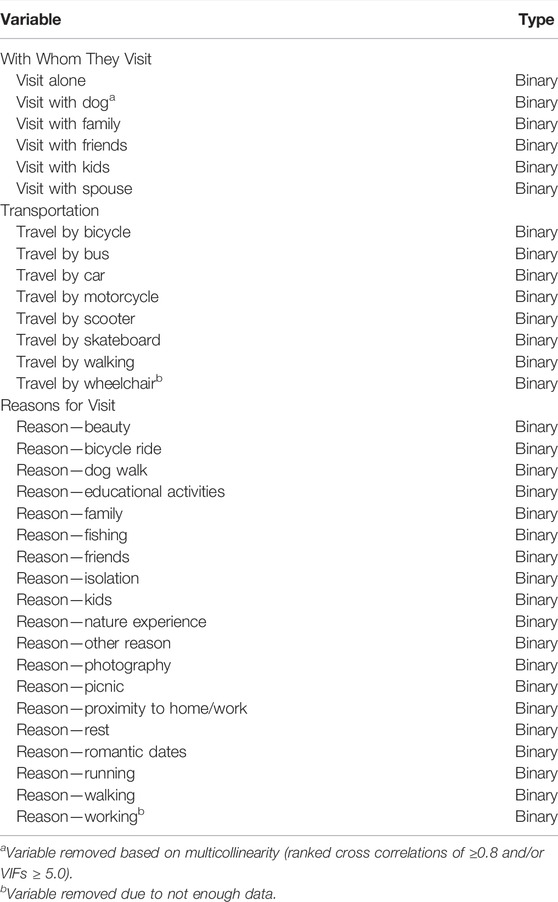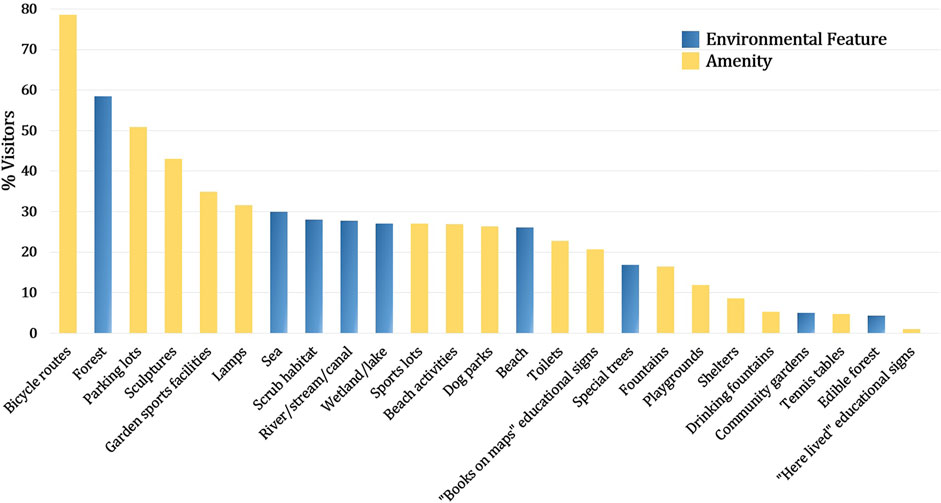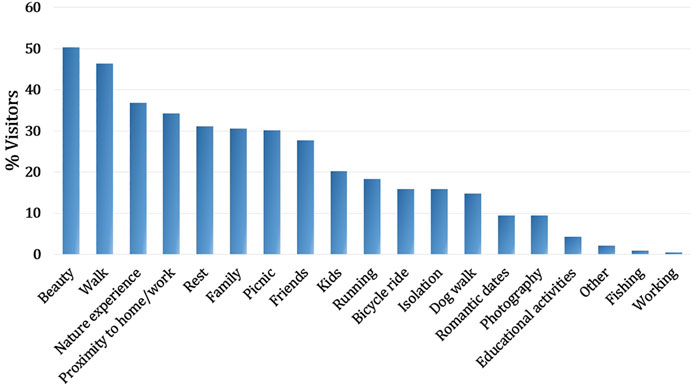- 1Porter School of the Environment and Earth Sciences, Tel Aviv University, Tel Aviv, Israel
- 2School of Plant Sciences and Food Security, Tel Aviv University, Tel Aviv, Israel
Urban nature sites are crucial places for the promotion of human health and well-being during the COVID-19 pandemic, but there are few interdisciplinary studies that simultaneously investigate the impact of a range of social and environmental factors on potential shifts in urban nature site visitation. We sought to do this by analyzing both geospatial data of the amenities and environmental features of urban nature sites with a web-based survey of urban nature site visitation in Tel Aviv-Yafo, Israel. We found that 53% of surveyed participants decreased visitation during the pandemic, while 26% increased visitation, 21% had no change, and only 1.7% were first-time visitors of urban nature sites. We developed a multiple linear regression model for shifts in visitation frequency during the pandemic, and found that a relative increase in visitation was positively associated with higher ratings of the physical and mental health contribution of the urban nature sites, higher nature maintenance and accessibility ratings, and visiting with a spouse, but negatively associated with variables such as car transportation, visit length, shrub habitat, age, and visiting alone or for romantic dates. Our results suggest that the perceived health benefits and accessibility of urban nature sites could be key in motivating visitation during the pandemic more than the specific environmental features or amenities of these sites. Given the on-going threats of the pandemic and other environmental crises, it is imperative to continue supporting the creation, maintenance, and monitoring of urban nature sites for not only urban ecosystems and biodiversity, but also so that they can contribute to the health of all urban residents.
1 Introduction
The novel coronavirus (COVID-19) pandemic has infected more than 480 million people worldwide since its first known infection in December 2019 (Johns Hopkins Coronavirus Resource Center, 2022). In response to the threat of transmission, countries implemented a range of policies such as restricting the use of public lands, closing schools and workplaces, forbidding social gatherings, implementing stay-at-home lockdown orders, and limiting non-essential travel on local to international scales (Ugolini et al., 2020; Geng et al., 2021). These actions helped to reduce the transmission of COVID-19, but these restrictions resulted in some negative effects on human mental and physical health (Xie et al., 2020; Allen, 2021; Fasano et al., 2021). Social isolation during the pandemic has been associated with higher rates of depression, anxiety, and sleep disorders (Xie et al., 2020; Ben-Ezra et al., 2021; Fasano et al., 2021; Olszewska-Guizzo et al., 2021), while restrictions of movement away from the home have been associated with reduced physical activity (Ugolini et al., 2020). During the COVID-19 pandemic, many of the most valuable and readily accessible places for the promotion of human physical and mental health have been urban nature (Heo et al., 2020; Shoari et al., 2020; Geng et al., 2021; O’Brien and Forster, 2021; Pouso et al., 2021; Robinson et al., 2021).
Visitation to urban nature such as parks, natural remnants, and gardens is generally associated with many physical and mental health benefits for people such as decreased rates of anxiety, stress, obesity, diabetes, and depression (Frumkin et al., 2017; Kothencz et al., 2017; Bratman et al., 2019; Schnell et al., 2019; Saadi et al., 2020; Berdejo-Espinola et al., 2021). Both urban green spaces (e.g., forests, scrub habitat, and places predominantly covered by vegetation) and urban blue spaces (e.g., all forms of natural and human made surface waters such as the sea, rivers, and ponds) are components of urban nature that have been shown to contribute positively to human health and well-being (Kaplan et al., 1998; Grellier et al., 2017; Olive and Wheaton, 2021; Pouso et al., 2021; Smith et al., 2021). People who visit urban nature more frequently and for longer periods of time tend to have higher contentment with their lives, improved social cohesion, lower rates of depression, and increased rates of physical activity (Shanahan et al., 2015, 2016; Xie et al., 2020; Yigitcanlar et al., 2020). Some studies demonstrated that visitation frequency and demand for urban nature generally increased since the beginning of the COVID-19 pandemic (Derks et al., 2020; Grima et al., 2020; Venter et al., 2020; Geng et al., 2021; Robinson et al., 2021; Weinbrenner et al., 2021), while others indicated that it tended to decrease (Xie et al., 2020; Curtis et al., 2021; Larson et al., 2021) or had very little change particularly in semi-natural and natural areas (Korpilo et al., 2021). As countries continue to adaptively manage their responses to the COVID-19 pandemic, there are still research gaps regarding which factors may impact urban nature visitation during this time and future crises (Venter et al., 2020; Korpilo et al., 2021).
Researchers are beginning to investigate how visitor perceptions of the physical and mental health contributions of urban nature may have changed during the COVID-19 pandemic, and how these perceptions may have influenced the use of urban nature (Chen et al., 2020; Berdejo-Espinola et al., 2021). Some studies showed that people generally visited nature for personal physical and/or mental health benefits to help them cope during the stress of the COVID-19 pandemic (Berdejo-Espinola et al., 2021; O’Brien and Forster, 2021; Robinson et al., 2021). For example, in a study of urban green space use in Brisbane, Australia, most participants attributed a higher level of importance to the personal physical and psychological benefits obtained from urban green spaces during the COVID-19 pandemic than before, and typically visited for these reasons more than for a sense of community (Berdejo-Espinola et al., 2021).
In addition to the physical and mental benefits of urban green and blue spaces, numerous factors may collectively influence how often people visit urban nature. These include land use and maintenance of natural and human-made features/amenities (Church, 2018; Talal and Santelmann, 2020, 2021; Talal et al., 2021), transportation options (Morzillo et al., 2016; Ugolini et al., 2020; Venter et al., 2020), and proximity/travel distance (Kaczynski et al., 2014; Shoari et al., 2020; Tu et al., 2020; Ugolini et al., 2020; Korpilo et al., 2021; Rice and Pan, 2021). Other influencing factors tend to include visitor perceptions of safety and accessibility (Hashim et al., 2016; Gu et al., 2020; Talal and Santelmann, 2021), demographics (Mak and Jim, 2019; Chen et al., 2020), and visitor motivations (Ugolini et al., 2020). Motivations for visiting urban nature during the COVID-19 pandemic may have shifted away from “non-essential” and/or “high risk” activities such as socializing with others toward “necessary” activities such as physical exercise and taking the dog out for a walk (Ugolini et al., 2020).
Altogether, recent studies provide more information on factors that may have influenced urban nature visitation frequency before and during the COVID-19 pandemic; however, there are few interdisciplinary studies that simultaneously investigated the combined impact of a range of social and environmental factors (Ugolini et al., 2020; Robinson et al., 2021). The purpose of our study was to better understand both the social and environmental factors (e.g., reasons for visits, transportation methods, amenities, environmental features, etc.) that may have influenced a potential shift in urban nature site visitation during the pandemic. We sought to address this research question by analyzing both geospatial data of the environmental features and amenities of urban nature sites with the results of a web-based survey regarding urban nature site visitation.
We predicted that the main drivers of shifts in urban nature site visitation would be related to the perceived mental and physical health benefits of the urban nature sites, the opportunity to socialize with others outside of their household in an outdoor setting during the closure of other indoor public spaces, and the ability access the sites without car or bus transportation (e.g., related to COVID-19 lockdown restrictions). We also anticipated that environmental features would be more influential for urban nature visitation than amenities, which might have introduced the potential for COVID-19 exposure. The findings of this type of interdisciplinary research may be used to enhance urban nature site management and improve the quality of life of residents at this time of the current pandemic and during potential future environmental and/or health crises.
2 Materials and Methods
2.1 Study Area
Our study was conducted in Tel Aviv-Yafo, a metropolitan city in Israel located along the eastern side of the Mediterranean Sea with a human population of 463,808 as of 2020 (The State of Israel Central Bureau of Statistics, 2021). In response to the COVID-19 pandemic declaration on by the World Health Organization (WHO) (World Health Organization, 2020), the Israeli government began implementing public health measures on 11 March 2020 and instituted a national state of emergency on 19 March 2020, which was followed by a series of lockdown restrictions (Ben-Ezra et al., 2021; Kaim et al., 2021). Some of the restrictions included stay-at-home orders for non-essential workers, restrictions regarding transportation (e.g., the use of public buses, private cars, and taxis), enforcing a maximum permitted travel distance from home, and limiting public outings to only two people from the same household.
Within the approximately 52 km2 city of Tel Aviv-Yafo, there were 64 urban nature sites as of April 2021 (Municipality of Tel Aviv-Yafo, 2021) (Figure 1). Urban nature sites are defined by the Tel Aviv-Yafo Municipality Environment and Sustainability Authority (2018) as public lands that are conserved, rehabilitated, and monitored to support nature and make them more accessible to the public for their enjoyment. The urban nature sites include features such as beaches, sand dunes, rivers, lakes, gardens, green roofs, and parks that were selected for additional protections based on a variety of reasons such as their ecological quality, species diversity, and connection to other sites within the city, which are defined in the city’s master plan and implemented in the provisions of the TA/5000 Zoning Plan for Tel Aviv-Yafo (Grossman, 2016; Tel Aviv-Yafo Municipality Environment and Sustainability Authority, 2018). Some photographic examples of the urban nature sites in Tel Aviv-Yafo are provided in Figure 2.
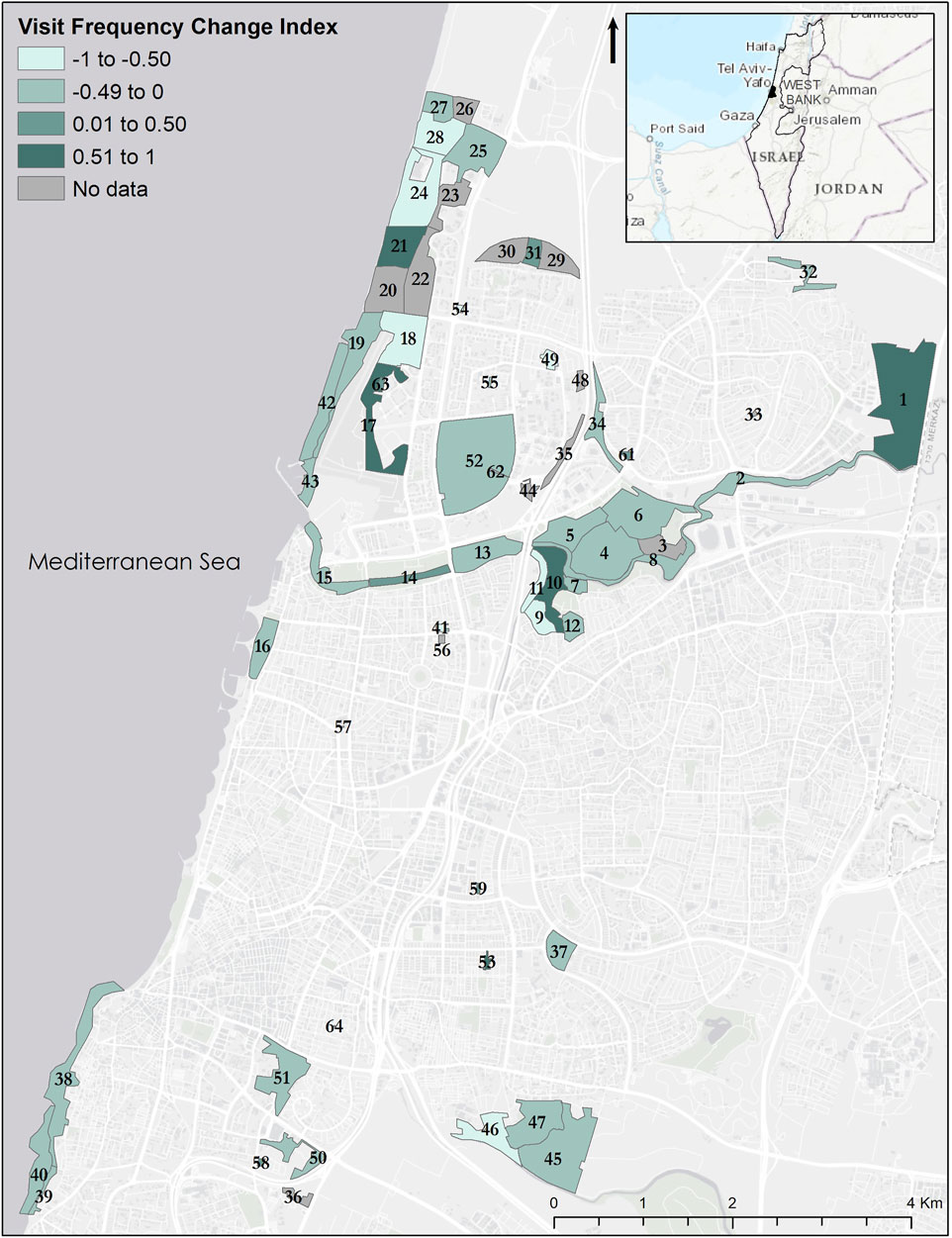
FIGURE 1. Urban nature sites in Tel Aviv-Yafo (n = 64) with the average visit frequency change index for before and during the COVID-19 pandemic. Site names are provided in Supplementary Material S1.
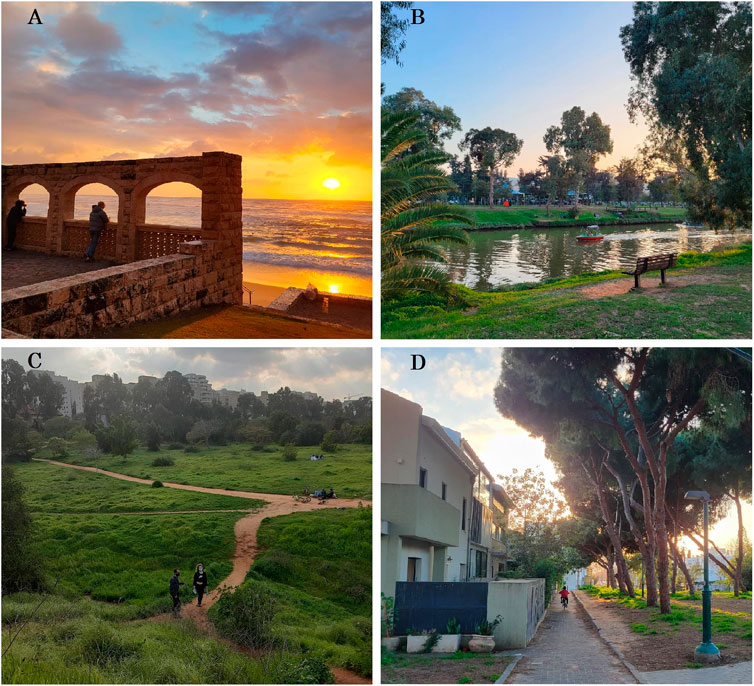
FIGURE 2. Examples of urban nature sites in Tel Aviv-Yafo (with their corresponding numbers in Figure 1 in parentheses): (A) Givat Aliya Beach and Gan Yitzhak Sadeh (39), (B) Nahal Yarkon Sportek section (14), (C) Afeka Center (31), and (D) Ramat Aviv A (52).
2.2 Geospatial Data Collection
We obtained geospatial data for the urban nature sites in Tel Aviv-Yafo from the Tel Aviv-Yafo Municipality iView v7.89 (Municipality of Tel Aviv-Yafo, 2021), which included maps and shapefiles for urban nature sites and a range of environmental features (i.e., beaches, community gardens, edible forest, sea, and special trees) and amenities (i.e., beach activities, bicycle routes, educational signs, dog parks, drinking fountains, fountains, garden sports activities, lamps, parking lots, playgrounds, sculptures, shelters, sports lots, tennis tables, and toilets). We obtained shapefiles for forest, river/stream/canal, scrub habitat, and wetland/lake from OpenStreetMap (OpenStreetMap contributors, 2021). Using ArcGIS Desktop 10.8.1, we calculated the area (hectares) of the urban nature sites and applied the intersect analysis tool to compute the geometric intersection of environmental features and amenities located within the urban nature site boundaries. We reviewed aerial maps to visually confirm the consistency and accuracy of the shapefiles for each of the urban nature sites, and then updated the data as necessary. The urban nature site environmental features and amenities variables included in the analysis are provided in Table 1.
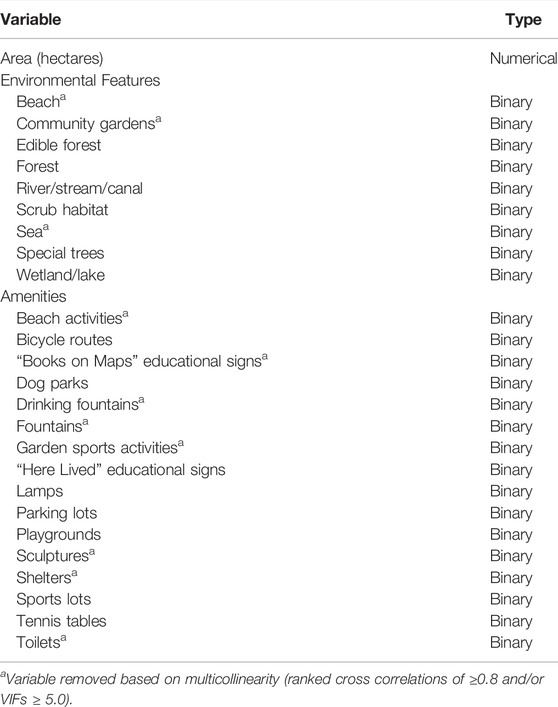
TABLE 1. Urban nature site variables, including area (hectares), environmental features, and amenities.
2.3 Survey Instrument
We developed our web-based survey for urban nature site visitation with collaboration and feedback from Tel Aviv University faculty and students, a consultant for the Tel Aviv-Yafo Municipality Environment & Sustainability Authority, the Israeli Ministry of Environmental Protection, and Reichman University (IDC Herzliya) faculty. We also conducted a focus group with residents of Tel Aviv-Yafo to review and refine the survey questions and answer choices. The survey was administered in the Hebrew language and was part of a greater study that examined urban nature site visitation, contribution to quality of life, preferences, and perceptions of ecosystem services. The survey was approved by the Tel Aviv University Institutional Review Board (IRB) on 2 February 2021 (No. 0002670-1) (Supplementary Material S2).
Our web-based survey was administered to participants living in Tel Aviv-Yafo from a range of demographic sectors by a local survey panel company, Panel4All (http://www.panel4all.co.il) between 21 March and 5 May 2021. The start of this sampling timeframe took place approximately 1.5 months after the end of the third lockdown in Israel. All survey participants were at least 18 years old and were residents of Tel Aviv-Yafo. Each participant provided informed consent and received a small monetary payment for completing the survey. We determined our participant sample size to be an optimal size of 384 participants, which was based on the Tel Aviv-Yafo population size with a margin of error of 5% and a confidence level of 95% (Bartlett et al., 2001; Rea and Parker, 2005). Our probabilistic sampling effort was limited by funding considerations, but we continued sampling until we achieved more than the optimal size of participants alongside an adequate theoretical saturation of responses.
The survey asked participants to select the urban nature site that they visit most in Tel Aviv-Yafo (i.e., if applicable), and then answer subsequent questions regarding their visitation frequency before and during the COVID-19 pandemic, if they visited alone or with others, transportation method(s), distance from home, length of visit, and reasons for visiting. The survey also included questions about the participants’ demographics and their ratings of the urban nature site’s contribution to their physical and mental health, accessibility, maintenance of natural and human-made features, and their overall experience. The survey is provided in the English language in the Supplementary Material S2.
2.4 Analysis
We prepared the survey data for analysis by translating the responses from Hebrew to English, reviewing the responses for consistency, and removing any surveys that were incomplete and/or had contradictory responses. We calculated descriptive statistics for the participants’ demographics, transportation methods, with whom they visited, visit length, reasons for visiting, distance from home, and their ratings. The survey variables are provided in Tables 2 and 3. We performed data analyses in R statistical software (R Core Team, 2021) and examined Cronbach’s α coefficients to measure the internal consistency evaluate the reliability of the constructs for the Likert scale questions (Cronbach, 1951) using the psych package (Revelle, 2021).
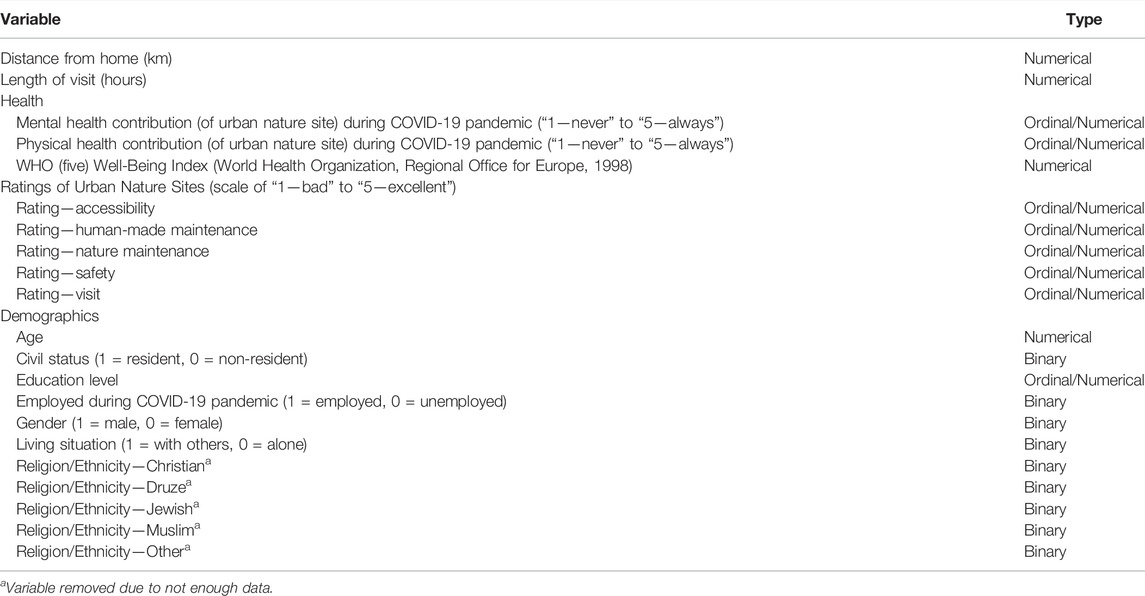
TABLE 3. Survey variables, including those for distance from home, visit length, health, ratings, and participant demographics.
We developed a multiple linear regression model for the change in visitation frequency using the MASS package (Venables and Ripley, 2002). We estimated the visitation frequency per year for each participant by recalculating their self-reported number of visits in the survey in terms of number of visits per year (e.g., 1 visit/week = 52 visits/year). We created a visitation frequency change index to measure the relative change in urban nature site visitation before and during the COVID-19 pandemic as a simple ratio, which we calculated to take on values between −1.0 and 1.0:
During the process of building the multiple linear regression model with the visitation change index as the dependent variable, we examined variable multicollinearity by creating a ranked cross-correlation matrix of the independent variables using the lares package (Lares, 2021) and computed a Variance Inflation Factor (VIF) for each independent variable using the car package (Fox and Weisberg, 2019). The model began with 80 independent variables, which also included the dummy variables for the categorical variables (Supplementary Material S1). To reduce multicollinearity, we examined the ranked cross correlations of ≥0.8 and VIFs ≥5.0 to guide our sequential elimination of variables. We removed the variables with the highest VIFs one at time, and recalculated VIFs in the model with the remaining variables until all VIFs were <5.0. We removed some variables due to a lack of sufficient data, which are noted in Tables 2 and 3. In the next steps of the model development, we used 61 independent variables.
We met the normality assumption for the model by evaluating residual plots and q-q plots with the ggplot2 package (Wickham, 2016), and also with the Kolmogorov-Smirnov (p = 0.789) and Shapiro-Wilk (p = 0.102) tests for normality using the olssr package (Hebbali, 2020). We identified and removed outliers that had a least a Cook’s distance of 3 times the mean, and the dependent variable did not require a transformation to achieve normality of the residuals. We then performed stepwise multiple linear regression for the model with the stepAIC() function (i.e., direction = “both”) using the MASS package (Venables and Ripley, 2002). At each step of the stepwise multiple linear regression, independent variables were selected by adding or removing them in succession and testing them based on p-values and their ability to reduce the Akaike information criterion (AIC) values (Akaike, 1974). After we developed the final stepwise linear multiple regression model, we standardized the regression coefficients along the same scale using the lm.beta package (Behrendt, 2014).
3 Results
In the following subsections, we provide information on survey participant demographics, a summary of the urban nature site visitation survey responses, and the results of our multiple linear regression analysis.
3.1 Participant Demographics
A total of 472 participants completed our web-based survey for urban nature site visitation (average completion time of 10 min), of which 14 were removed from the analysis based on incomplete and/or contradictory responses. The demographics of our 458 remaining participants, including both visitors and non-visitors in comparison to residents in the Tel Aviv-Yafo region, are provided in Table 4. The average age of the participants was 42 years old (range of 18–91 years old) and the group included 56% females and 44% males. Of the participants who were at least 27 years old (i.e., the average graduation age for a bachelor’s degree in Israel), 64% had at least a bachelor’s degree. The combined percentage of full-time and part-time employment was slightly higher for visitors than non-visitors before the COVID-19 pandemic, but unemployment increased for both groups during the pandemic. The self-reported WHO (five) Well-Being Index (World Health Organization - Regional Office for Europe, 1998) for visitors and non-visitors was approximately the same.
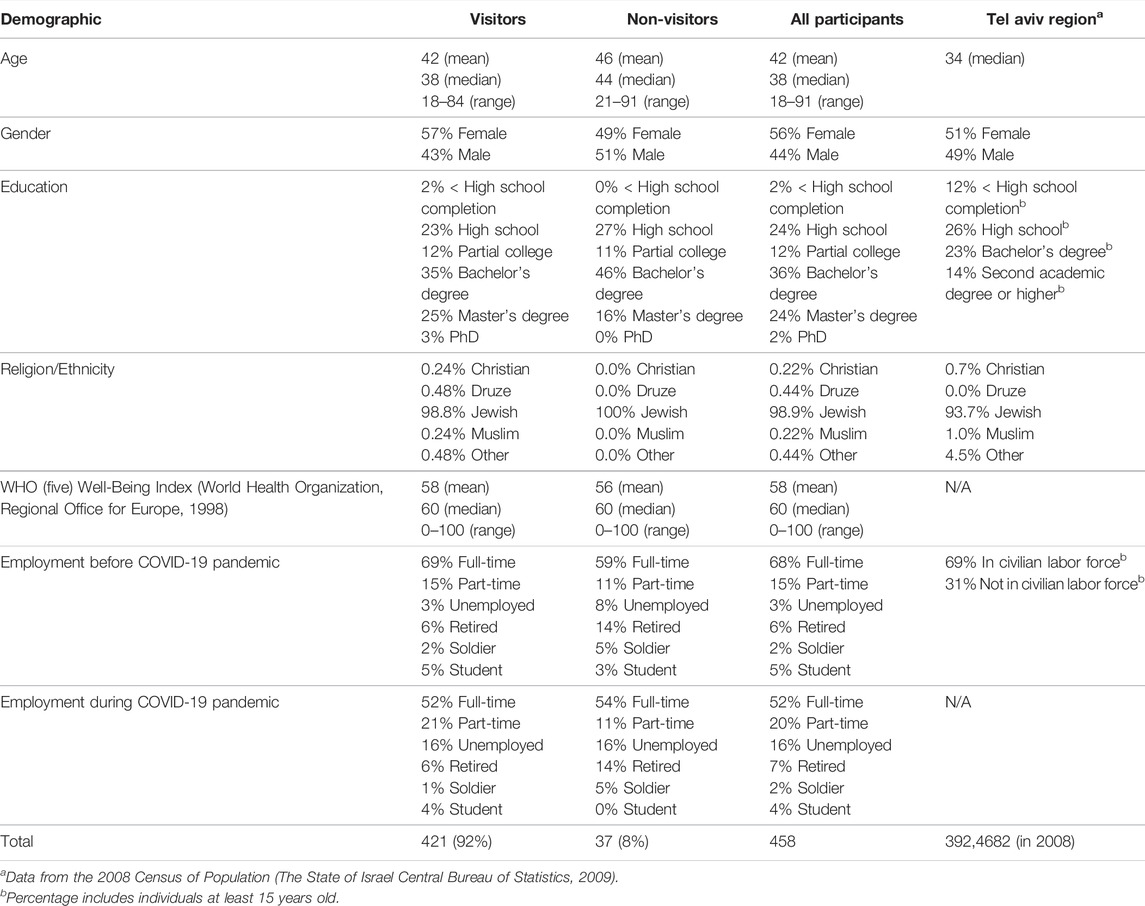
TABLE 4. Demographics for participant visitors, participant non-visitors, all participants, and the Tel-Aviv Region population.
Overall, the demographics of the participants were relatively comparable to the Tel Aviv region (The State of Israel Central Bureau of Statistics, 2009), except for a slightly higher age (i.e., our study only included participants aged 18 or older), slightly more female and less male participants, a greater percentage of participants with at least a bachelor’s degree or higher, a slightly lower percentage of underrepresented religious/ethnic groups, and a greater percentage of employed participants. It is important to note that the last completed census for the Tel Aviv Region was in 2008 and our study was conducted in 2021. In addition, some of the census variables included data for individuals 15 years old and older, whereas all of our study participants were at least 18 years old.
3.2 Survey Results
The urban nature site visitation survey revealed that 421 participants (57% female, 43% male) visited urban nature sites in Tel-Aviv Yafo at least once before or during the COVID-19 pandemic, while 37 participants were non-visitors (49% female, 51% male) (Table 4). The average age of the urban nature site visitors was slightly lower than non-visitors. Of the 64 urban nature sites in Tel Aviv-Yafo, 50 urban nature sites (78%) were selected by participants as the ones that they visited most often. Figure 3 shows the environmental variables and amenities of the urban nature sites that were most often visited by the survey participants.
We compared visitation frequency of urban nature sites before and during the COVID-19 pandemic, and found that 53% of the surveyed visitors decreased visitation, 26% increased visitation, and 21% had no change. Only 1.7% of the participants were first-time visitors of urban nature sites during the pandemic. The average number of urban nature site visits before the pandemic was 81 visits per year, while the average was 66 visits per year during the pandemic. There was a positive Spearman’s rank correlation between visitation frequency before and during the pandemic, r (419) = 0.425, p < 0.001. Figure 1 shows the average visitation change index for our participants according to urban nature site.
The visitors provided information about their visits, such as their transportation method, if they visited alone and/or with others, and their visit length (Figure 4). The most common ways of visiting the urban nature sites were with friends, family, or alone, and 48% of visitors selected two or more options. The average visit was approximately 1.8 h, with a median of 2 h. In regards to transportation, 76% of visitors had one preferred method of transportation to the urban nature sites, while 24% selected two or more ways. The most popular modes of transportation were walking (61%) and traveling by car (37%). The results indicated that when an urban nature site was 5 km or less from home, 70% of visitors selected walking; however, when an urban nature site was more than 5 km from home, 78% of visitors used car transportation. The urban nature sites were located an average of 2.9 km from participants’ homes with a range of 0–15 km.
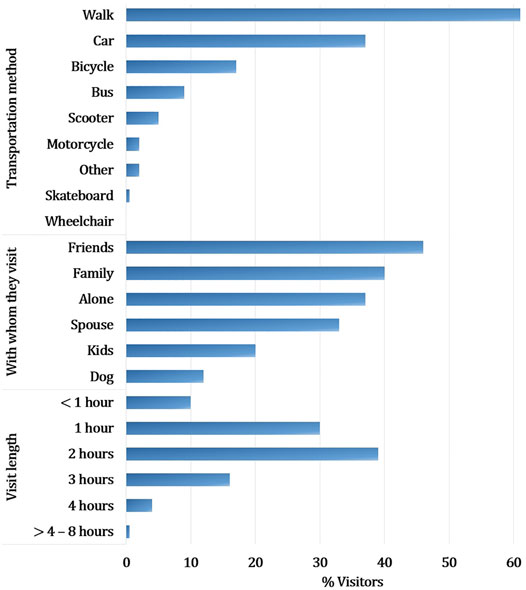
FIGURE 4. Characteristics of urban nature site visits by transportation method, with whom they visited, and visit length by percentage of visitors.
When asked about their reasons for visiting the urban nature sites, the most common responses were to enjoy the beauty, go for a walk, and have a nature experience (Figure 5). Approximately 34% of visitors indicated that they visited because the urban nature site was in close proximity to their home and/or work and 81% percent of visitors had two or more reasons for visiting. The visitors also provided their ratings of the accessibility, safety, maintenance of human-made features, nature maintenance, and their overall visit to the urban nature sites (e.g., as “excellent”, “good”, “fair”, “bad”, “very bad”). The median ranking for each of these categories was “good”, with the exception of “human-made structures,” which received a median answer of “fair”. In terms of the reliability, the Cronbach’s α for the independent variables constructed from the Likert scales were all above the threshold of 0.7, which is considered to be reliable.
3.3 Multiple Linear Regression Model Results
The results of the stepwise multiple linear regression model for the visitation change index with the statistically significant variables is shown in Table 5. Each of the 24 variables selected for the final model contributed to the model’s predictive ability and helped to improve performance by reducing the Akaike Information Criterion (AIC) values. The results of the final regression equation explained 44% of the variance and the model was a significant predictor of visit frequency change index, F (24, 335) = 11, p < 0.001.
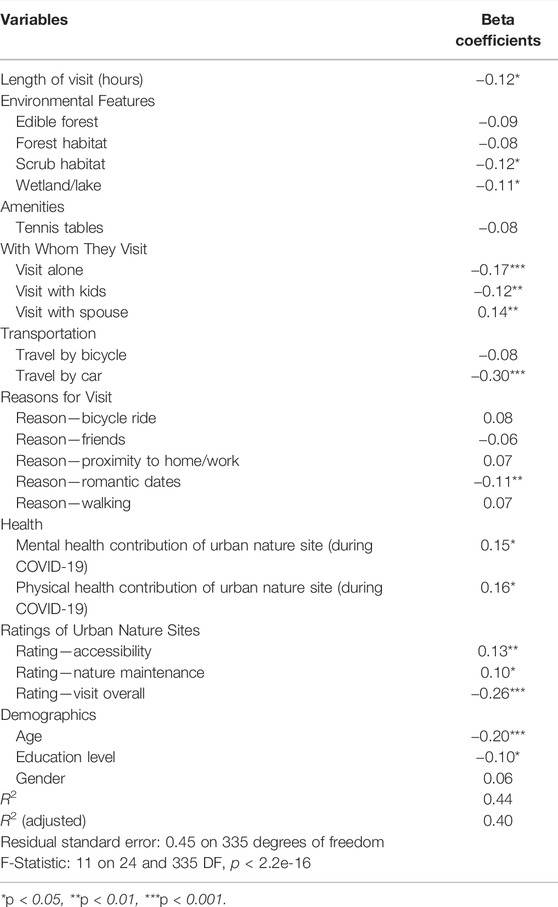
TABLE 5. Multiple linear regression model results for the visitation frequency relative change index.
The model showed that the visitation change index was positively associated with the higher ratings of the physical and mental health contribution of the urban nature site during the COVID-19 pandemic, higher accessibility and nature maintenance ratings, and visiting with a spouse. The model was negatively associated with length of visit (hours), scrub and wetland/lake habitats, visiting alone or with kids, traveling by car, visiting for the purpose of romantic dates, overall visit rating, age, and education level. In other words, the participants who had a relative increase in urban nature visitation during the COVID-19 pandemic tended to prefer shorter duration visits with a spouse that did not require car transportation. These participants tended to be younger and visited urban nature sites that they felt were highly accessible, had good nature maintenance, and contributed to their mental and physical health more than for their specific environmental features or amenities.
4 Discussion
Our study examined a range of social and environmental factors associated with the frequency of urban nature site visitation during the COVID-19 pandemic. We found that urban nature site visitation decreased for the majority of our participants during the pandemic, which is consistent with some studies (Xie et al., 2020; Curtis et al., 2021; Larson et al., 2021), but contrary to other research that showed a relative increase in visitation frequency during the pandemic (Derks et al., 2020; Grima et al., 2020). We also found that only 1.7% of our participants were first-time visitors to urban nature sites, which was far lower than another study that showed that 45% of previous non-users of urban green space were first-time users during the pandemic restrictions period (Berdejo-Espinola et al., 2021). These differences may be related to the types and intensity of pandemic-related restrictions (Geng et al., 2021) or due to the accessibility of urban nature sites in Tel Aviv-Yafo compared to other cities or regions.
Consistent with our predictions, the participants in our study who had a relative increase in urban nature site visitation during the pandemic reported that urban nature sites had high contributions to their mental and physical health. This result is similar to the results of other studies that characterized urban nature as some of the most valuable places for the promotion of human physical and mental health during the pandemic (Heo et al., 2020; Shoari et al., 2020; Geng et al., 2021; O’Brien and Forster, 2021; Robinson et al., 2021). Our participants who visited urban nature sites relatively more often during the pandemic also gave higher ratings for accessibility and nature maintenance, which were previously shown to play important roles in urban nature visitation (Talal et al., 2021; Talal and Santelmann, 2021). In line with our predictions, participants in our study tended to not use car transportation; however, they also preferred shorter duration visits to urban nature sites in closer proximity to home or work, which are likely related to accessibility and a desire to follow pandemic-related restrictions. Surprisingly, the participants’ ratings of accessibility and the mental and physical health benefits of the sites were more positively associated with visitation frequency than ratings for overall experience, which implies that even shorter duration visits to accessible urban nature sites still had health benefits for participants even if they may have preferred a better overall experience.
We predicted that a higher visitation frequency would be associated with socializing with others outside of their household in an outdoor setting, but found that participants who visited urban nature sites relatively more often during the COVID-19 pandemic tended to visit with a spouse rather than with friends, children, alone, or for romantic dates. This result may be related to visitors obtaining some of the health benefits of urban nature with a domestic partner while also reducing the risk of COVID-19 exposure and following pandemic-related restrictions. In addition, our results indicated that visitation frequency was not positively associated with amenities such as tennis tables or sports facilities even though these are designed to promote physical activity. The low appeal of these amenities during the pandemic may have been because they were perceived as posing unnecessary health risks related to socializing with others in their communities. Previous studies also reported that urban nature visitors during the pandemic prioritized a sense of community lower than the personal physical and psychological benefits of urban nature (Berdejo-Espinola et al., 2021), and that motivations for visiting urban nature during the pandemic may have shifted away from “high risk” activities such as socializing with others (Ugolini et al., 2020).
We anticipated that environmental features would be more associated with a relative increase in urban nature visitation than amenities during the COVID-19 pandemic, but the results of our study did not show many clear environmental preferences. We found that urban nature visitation was negatively associated with scrub and wetland/lake habitats, but there were no significant positive associations with other environmental characteristics. There is extensive previous research that describes how humans have strong preferences for both urban green and urban blue spaces (Kaplan and Kaplan, 1989; Grellier et al., 2017; Häggström, 2019; Smith et al., 2021; Talal et al., 2021); however, perhaps in the context of the pandemic, it is likely that numerous social factors and motivations had stronger associations and influence on urban nature site visitation. It is also possible that urban nature site visitors had an increased level of flexibility during the pandemic in terms of visiting a wider variety of urban nature sites regardless of their specific environmental features or human-made amenities, provided that they were adequately accessible and had the potential to deliver mental and physical health benefits.
Our results indicated some patterns in the demographics of participants who visited urban nature sites. We found that higher urban nature visitation during the pandemic was negatively correlated with age and higher levels of education. Our finding related to age is comparable to other studies that showed less frequent urban nature visitation during the pandemic among older adults (Berdejo-Espinola et al., 2021; Curtis et al., 2021; Rice and Pan, 2021), but different from research that found that older adults were one of the demographic groups more likely to use urban nature during the pandemic (Uchiyama and Kohsaka, 2020; Yamazaki et al., 2021). A decrease in urban nature visitation by older adults during the pandemic may have been related to an awareness of their increased risk of COVID-19 transmission and its serious health implications in comparison to younger populations (Curtis et al., 2021). In addition, some older adults may have been more likely than younger individuals to follow social distancing recommendations and stay-at-home orders (O’Brien and Forster, 2021; Rice and Pan, 2021); however, this may have also resulted in them being disproportionately vulnerable to social isolation during the pandemic, as well as intensified the on-going inequitable access to urban nature for older residents (Onose et al., 2020).
4.1 Limitations and Future Research
Our study elucidated many of the social and environmental factors associated with the relative change in urban nature visitation during the COVID-19 pandemic, but there also were some potential limitations. The web-based survey was conducted during a particular window of time of the pandemic, thereby limiting a deeper understanding of changes in urban nature site visitation between various lockdown periods in Tel Aviv Yafo. In addition, the web-based format of the survey was only accessible to individuals who had internet access and the survey panel company only involved individuals who were fluent in the Hebrew language. We did not have any participants who used a wheelchair, and so future studies should aim to include participants with a broader range of physical and mental health conditions.
In our survey, we asked participants about the urban nature site that they visited the most in order to be able to correlate them with specific variables of that particular site and also so that participants would be able to complete the survey within an available timeframe; however, it is likely that participants visited a variety of urban nature sites before and during the COVID-19 pandemic. Future studies would benefit from a Public Participation GIS (PPGIS) approach (Korpilo et al., 2021) or a combined qualitative-participatory GIS approach (Hand et al., 2017), in which participants would be able to mark multiple urban nature sites and provide more in-depth information about their experiences and the characteristics of their visits. Our initial data collection plan was to also conduct an on-site survey of visitors to the urban nature sites, as these can often reveal more authentic, in-depth responses not available in an off-site context (Qiu et al., 2013), but this was not possible due COVID-19 transmission concerns.
Our study was specifically about public lands designated as urban nature sites in Tel Aviv-Yafo, but it did not include all types of urban nature in the city such as private gardens, green boulevards, urban parks, bioswales, and street trees. Additional studies across different types of urban nature and visitor activities will be helpful in discerning potential similarities or differences in use and accessibility (Ugolini et al., 2020; Dawwas and Dyson, 2021). We also acknowledge that there may be additional variables that might have not been captured in the stepwise multiple regression analysis. Future studies would benefit from an on-site survey of urban nature visitors and also be conducted in a range of languages and in a variety of types of urban nature and climates. In this manner, future research would improve our understanding of the many social and environmental factors that influence urban nature visitation during the pandemic and potential future crises.
4.2 Conclusions
Our research suggests that urban nature sites are crucial places for the promotion of human health and well-being during the COVID-19 pandemic. Visitation to urban nature sites generally decreased for most of our participants, but individuals who had a relative increase in visitation reported that the physical and mental health benefits, nature maintenance, and accessibility were key factors. We found that these participants tended to be younger in age and preferred shorter duration visits that did not require car transportation. In addition, they tended to visit urban nature sites with a spouse rather than with kids, alone, or for romantic dates. In many aspects, social factors and accessibility appeared to have greater associations with a relative increase in urban nature site visitation during the pandemic than the particular environmental features or amenities of the urban nature sites. Even so, based on the positive physical and mental health benefits of urban nature, it is imperative to continue supporting the creation, maintenance, and monitoring of urban nature sites during and after the pandemic for both people and the environment.
Given the continued threats of the pandemic and other environmental crises, we recommend that urban nature sites be made more accessible in terms of their proximity, amenities, and safety and security for people of all ages, mental and physical health conditions, and sociodemographic backgrounds (Rigolon, 2016; Smiley et al., 2016; Talal and Santelmann, 2020; De Haas et al., 2021). Based on the current map of urban nature sites in Tel Aviv-Yafo (Figure 1), there appears to be an inequitable distribution favoring the northern part of the city, which is known to have higher-income neighborhoods that are less socio-demographically diverse than neighborhoods in the southern portion of the city. The inequitable distribution of urban nature may not only minimize urban residents’ fair access to the many mental and physical health benefits of urban green and blue spaces, but it may also expose underserved populations to a range of environmental hazards such as the urban heat island effect, flooding, water and air pollution, and other environmental injustices (Agyeman et al., 2016; Meerow and Newell, 2017; Ibsen et al., 2021).
Planners, policymakers, and managers should seek to involve a diverse range of stakeholders and partners (Guenat et al., 2021) and use participatory methods to engage local communities (Floyd, 2014; Malanson et al., 2021) and improve the accessibility and maintenance of urban nature sites for people of all sociodemographic backgrounds, particularly in underserved neighborhoods. In addition, Tel Aviv-Yafo and other cities should seek to implement improved funding mechanisms to better maintain, restore, and protect urban nature from future infrastructure development. Throughout the COVID-19 pandemic and potential future health and environmental crises, urban nature will continue to play an extensive role in promoting human health and well-being, as well as mitigating the increasing pressures of climate change, intensive land use, human population growth, and threats to biodiversity within our cities.
Data Availability Statement
The original contributions presented in the study are included in the article/Supplementary Material, further inquiries can be directed to the corresponding author.
Ethics Statement
The studies involving human participants were reviewed and approved by the Tel Aviv University Institutional Review Board (IRB) on February 2, 2021 (No. 0002670-1). The participants provided their written informed consent to participate in this study.
Author Contributions
MT and MG contributed to the conception and design of the study. MT organized and analyzed the data, performed the data analysis, and wrote the manuscript. MG provided guidance and review for the data analysis and manuscript revisions. Both MT and MG approved the submitted version.
Funding
MT is supported in part by the Zuckerman STEM Leadership Program.
Conflict of Interest
The authors declare that the research was conducted in the absence of any commercial or financial relationships that could be construed as a potential conflict of interest.
Publisher’s Note
All claims expressed in this article are solely those of the authors and do not necessarily represent those of their affiliated organizations, or those of the publisher, the editors and the reviewers. Any product that may be evaluated in this article, or claim that may be made by its manufacturer, is not guaranteed or endorsed by the publisher.
Acknowledgments
We thank the many individuals who provided feedback for our survey: Ana Trakhtenbrot, Orly Ronen, Shiri Zemah Shamir, and members of the MG and Yuval Sapir Laboratories at Tel Aviv University.
Supplementary Material
The Supplementary Material for this article can be found online at: https://www.frontiersin.org/articles/10.3389/fenvs.2022.874707/full#supplementary-material
References
Agyeman, J., Schlosberg, D., Craven, L., and Matthews, C. (2016). Trends and Directions in Environmental justice: from Inequity to Everyday Life, Community, and Just Sustainabilities. Annu. Rev. Environ. Resour. 41, 321–340. doi:10.1146/annurev-environ-110615-090052
Akaike, H. (1974). A New Look at the Statistical Model Identification. IEEE Trans. Automat. Contr. 19, 716–723. doi:10.1109/TAC.1974.1100705
Allen, D. W. (2021). Covid-19 Lockdown Cost/Benefits: A Critical Assessment of the Literature. Int. J. Econ. Business 29, 1–32. doi:10.1080/13571516.2021.1976051
Bartlett, J. E., Kotrlik, J. W., and Higgins, C. C. (2001). Organizational Research: Determining Appropriate Sample Size in Survey Research. Inf. Technol. Learn. Perform. J. 19, 8.
Behrendt, S. (2014). lm.beta: Add Standardized Regression Coefficients to Lm-Objects. R package version 1.5-1. Available at: https://CRAN.R-project.org/package=lm.beta.
Ben-Ezra, M., Hamama-Raz, Y., Goodwin, R., Leshem, E., and Levin, Y. (2021). Association between Mental Health Trajectories and Somatic Symptoms Following a Second Lockdown in Israel: a Longitudinal Study. BMJ Open 11, e050480. doi:10.1136/bmjopen-2021-050480
Berdejo‐Espinola, V., Suárez‐Castro, A. F., Amano, T., Fielding, K. S., Oh, R. R. Y., and Fuller, R. A. (2021). Urban green Space Use during a Time of Stress: A Case Study during the COVID‐19 Pandemic in Brisbane, Australia. People Nat. 3, 597–609. doi:10.1002/pan3.10218
Bratman, G. N., Anderson, C. B., Berman, M. G., Cochran, B., de Vries, S., Flanders, J., et al. (2019). Nature and Mental Health: An Ecosystem Service Perspective. Sci. Adv. 5, eaax0903. doi:10.1126/sciadv.aax0903
Chen, C., Luo, W., Li, H., Zhang, D., Kang, N., Yang, X., et al. (2020). Impact of Perception of Green Space for Health Promotion on Willingness to Use Parks and Actual Use Among Young Urban Residents. Ijerph 17, 5560. doi:10.3390/ijerph17155560
Church, S. P. (2018). From Street Trees to Natural Areas: Retrofitting Cities for Human Connectedness to Nature. J. Environ. Plann. Manage. 61, 878–903. doi:10.1080/09640568.2018.1428182
Cronbach, L. J. (1951). Coefficient Alpha and the Internal Structure of Tests. Psychometrika 16, 38. doi:10.1007/bf02310555
Curtis, D. S., Rigolon, A., Schmalz, D. L., and Brown, B. B. (2021). Months of the COVID-19 Pandemic: Getting Out while Staying in. Environ. Behav., 29. doi:10.1177/00139165211031199
Dawwas, E. B., and Dyson, K. (2021). COVID-19 Changed Human-Nature Interactions across Green Space Types: Evidence of Change in Multiple Types of Activities from the West Bank, Palestine. Sustainability 13, 13831. doi:10.3390/su132413831
De Haas, W., Hassink, J., and Stuiver, M. (2021). The Role of Urban Green Space in Promoting Inclusion: Experiences from the Netherlands. Front. Environ. Sci. 9, 618198. doi:10.3389/fenvs.2021.618198
Derks, J., Giessen, L., and Winkel, G. (2020). COVID-19-induced Visitor Boom Reveals the Importance of Forests as Critical Infrastructure. For. Pol. Econ. 118, 102253. doi:10.1016/j.forpol.2020.102253
Fasano, M. V., Padula, M., Azrak, M. Á., Avico, A. J., Sala, M., and Andreoli, M. F. (2021). Consequences of Lockdown during COVID-19 Pandemic in Lifestyle and Emotional State of Children in Argentina. Front. Pediatr. 9, 660033. doi:10.3389/fped.2021.660033
Floyd, M. F. (2014). Social Justice as an Integrating Force for Leisure Research. Leis. Sci. 36, 379–387. doi:10.1080/01490400.2014.917002
Fox, J., and Weisberg, S. (2019). An {R} Companion to Applied Regression. Third Edition. Thousand Oaks, CA. Sage. Available at: https://socialsciences.mcmaster.ca/jfox/Books/Companion/.
Frumkin, H., Bratman, G. N., Breslow, S. J., Cochran, B., Kahn Jr, P. H., Lawler, J. J., et al. (2017). Nature Contact and Human Health: A Research Agenda. Environ. Health Perspect. 125, 075001. doi:10.1289/EHP1663
Geng, D., Innes, J., Wu, W., and Wang, G. (2021). Impacts of COVID-19 Pandemic on Urban Park Visitation: a Global Analysis. J. For. Res. 32, 553–567. doi:10.1007/s11676-020-01249-w
Grellier, J., White, M. P., Albin, M., Bell, S., Elliott, L. R., Gascón, M., et al. (2017). BlueHealth: a Study Programme Protocol for Mapping and Quantifying the Potential Benefits to Public Health and Well-Being from Europe's Blue Spaces. BMJ Open 7, e016188. doi:10.1136/bmjopen-2017-016188
Grima, N., Corcoran, W., Hill-James, C., Langton, B., Sommer, H., and Fisher, B. (2020). The Importance of Urban Natural Areas and Urban Ecosystem Services during the COVID-19 Pandemic. PLOS ONE 15, e0243344. doi:10.1371/journal.pone.0243344
Grossman, M. (2016). Tel Aviv Passes Plan to Protect Urban Nature Sites. Jerus. Post. Available at: https://www.jpost.com/business-and-innovation/environment/tel-aviv-passes-plan-to-protect-urban-nature-sites-441610.
Gu, X., Li, Q., and Chand, S. (2020). Factors Influencing Residents' Access to and Use of Country parks in Shanghai, China. Cities 97, 102501. doi:10.1016/j.cities.2019.102501
Guenat, S., Porras Lopez, G., Mkwambisi, D. D., and Dallimer, M. (2021). Unpacking Stakeholder Perceptions of the Benefits and Challenges Associated with Urban Greenspaces in Sub-saharan Africa. Front. Environ. Sci. 9, 591512. doi:10.3389/fenvs.2021.591512
Häggström, M. (2019). Being in the forest-A Matter of Cultural Connections with a Natural Environment. PLANTS PEOPLE PLANET. 1, 221–232. doi:10.1002/ppp3.10056
Hand, C., Huot, S., Laliberte Rudman, D., and Wijekoon, S. (2017). Qualitative-Geospatial Methods of Exploring Person-Place Transactions in Aging Adults: A Scoping Review. Geront, gnw130. doi:10.1093/geront/gnw130
Hashim, N. H. M., Thani, S. K. S. O., Jamaludin, M. A., and Yatim, N. M. (2016). A Perceptual Study on the Influence of Vegetation Design towards Women's Safety in Public Park. Proced. - Soc. Behav. Sci. 234, 280–288. doi:10.1016/j.sbspro.2016.10.244
Hebbali, A. (2020). Tools for Building OLS Regression Models. Available at: https://CRAN.R-project.org/package=olsrr.
Heo, S., Lim, C. C., and Bell, M. L. (2020). Relationships between Local Green Space and Human Mobility Patterns during COVID-19 for Maryland and California, USA. Sustainability 12, 9401. doi:10.3390/su12229401
Ibsen, P. C., Borowy, D., Dell, T., Greydanus, H., Gupta, N., Hondula, D. M., et al. (2021). Greater Aridity Increases the Magnitude of Urban Nighttime Vegetation-Derived Air Cooling. Environ. Res. Lett. 16, 034011. doi:10.1088/1748-9326/abdf8a
Johns Hopkins Coronavirus Resource Center (2022). COVID-19 Map. Available at: http://coronovirus.jhu.edu/map.html (Accessed March 27, 2022).
Kaczynski, A. T., Besenyi, G. M., Stanis, S. A. W., Koohsari, M. J., Oestman, K. B., Bergstrom, R., et al. (2014). Are Park Proximity and Park Features Related to Park Use and Park-Based Physical Activity Among Adults? Variations by Multiple Socio-Demographic Characteristics. Int. J. Behav. Nutr. Phys. Act. 11, 146. doi:10.1186/s12966-014-0146-4
Kaim, A., Siman-Tov, M., Jaffe, E., and Adini, B. (2021). Factors that Enhance or Impede Compliance of the Public with Governmental Regulation of Lockdown during COVID-19 in Israel. Int. J. Disaster Risk Reduction 66, 102596. doi:10.1016/j.ijdrr.2021.102596
Kaplan, R., and Kaplan, S. (1989). The Experience of Nature: A Psychological Perspective. Cambridge: Cambridge University Press.
Korpilo, S., Kajosaari, A., Rinne, T., Hasanzadeh, K., Raymond, C. M., and Kyttä, M. (2021). Coping with Crisis: Green Space Use in Helsinki before and during the COVID-19 Pandemic. Front. Sustain. Cities 3, 713977. doi:10.3389/frsc.2021.713977
Kothencz, G., Kolcsár, R., Cabrera-Barona, P., and Szilassi, P. (2017). Urban Green Space Perception and its Contribution to Well-Being. Ijerph 14, 766. doi:10.3390/ijerph14070766
Lares, B. (2021). Lares: Analytics, Data Mining & Machine Learning Sidekick. Available at: https://CRAN.R-project.org/package=lares.
Larson, L. R., Zhang, Z., Oh, J. I., Beam, W., Ogletree, S. S., Bocarro, J. N., et al. (2021). Urban Park Use during the COVID-19 Pandemic: Are Socially Vulnerable Communities Disproportionately Impacted? Front. Sustain. Cities 3, 710243. doi:10.3389/frsc.2021.710243
Mak, B. K. L., and Jim, C. Y. (2019). Linking Park Users' Socio-Demographic Characteristics and Visit-Related Preferences to Improve Urban parks. Cities 92, 97–111. doi:10.1016/j.cities.2019.03.008
Malanson, G. P., Talal, M. L., Pansing, E. R., and Franklin, S. B. (2021). Vegetation Ecology with Anthropic Drivers and Consequences. Prog. Phys. Geogr. Earth Environ. 45, 446–459. doi:10.1177/0309133321999371
Meerow, S., and Newell, J. P. (2017). Spatial Planning for Multifunctional green Infrastructure: Growing Resilience in Detroit. Landscape Urban Plann. 159, 62–75. doi:10.1016/j.landurbplan.2016.10.005
Morzillo, A. T., Kreakie, B. J., Netusil, N. R., Yeakley, J. A., Ozawa, C. P., and Duncan, S. L. (2016). Resident Perceptions of Natural Resources between Cities and across Scales in the Pacific Northwest. E&S 21. doi:10.5751/ES-08478-210314
Municipality of Tel Aviv-Yafo (2021). Tel Aviv-Yafo GIS Maps. Available at: https://gisn.tel-aviv.gov.il/.
O’Brien, L., and Forster, J. (2021). Physical Activity Supporting Connection to Nature, and Helping to Maintain Wellbeing during the Covid-19 Restrictions in England. Ijerph 18, 4585. doi:10.3390/ijerph18094585
Olive, R., and Wheaton, B. (2021). Understanding Blue Spaces: Sport, Bodies, Wellbeing, and the Sea. J. Sport Soc. Issues 45, 3–19. doi:10.1177/0193723520950549
Olszewska-Guizzo, A., Fogel, A., Escoffier, N., and Ho, R. (2021). Effects of COVID-19-Related Stay-At-home Order on Neuropsychophysiological Response to Urban Spaces: Beneficial Role of Exposure to Nature? J. Environ. Psychol. 75, 101590. doi:10.1016/j.jenvp.2021.101590
Onose, D. A., Iojă, I. C., Niță, M. R., Vânău, G. O., and Popa, A. M. (2020). Too Old for Recreation? How Friendly Are Urban Parks for Elderly People? Sustainability 12, 790. doi:10.3390/su12030790
OpenStreetMap contributors(2021). israel-and-palestine-latest-free. shp.zip. Karlsruhu, Germany: Geofabrik GmbH. Available at: http://download.geofabrik.de/asia/israel-and-palestine-latest-free.shp.zip.
Pouso, S., Borja, Á., Fleming, L. E., Gómez-Baggethun, E., White, M. P., and Uyarra, M. C. (2021). Contact with Blue-green Spaces during the COVID-19 Pandemic Lockdown Beneficial for Mental Health. Sci. Total Environ. 756, 143984. doi:10.1016/j.scitotenv.2020.143984
Qiu, L., Lindberg, S., and Nielsen, A. B. (2013). Is Biodiversity Attractive?-On-Site Perception of Recreational and Biodiversity Values in Urban green Space. Landscape Urban Plann. 119, 136–146. doi:10.1016/j.landurbplan.2013.07.007
R Core Team (2021). R: A Language and Environment for Statistical Computing. Vienna, Austria: R Foundation for Statistical Computing. Available at: https://www.R-project.org/.
Rea, L. M., and Parker, R. A. (2005). Designing and Conducting Survey Research: A Comprehensive Guide. 3rd Edition. Wiley & Sons, Inc.
Revelle, W. (2021). Psych: Procedures for Psychological, Psychometric, and Personality Research. Evanson, Illinois: Northwestern UniversityAvailable at: https://CRAN.R-project.org/package=psych.
Rice, W. L., and Pan, B. (2021). Understanding Changes in Park Visitation during the COVID-19 Pandemic: A Spatial Application of Big Data. Wellbeing, Space Soc. 2, 100037. doi:10.1016/j.wss.2021.100037
Rigolon, A. (2016). A Complex Landscape of Inequity in Access to Urban parks: A Literature Review. Landscape Urban Plann. 153, 160–169. doi:10.1016/j.landurbplan.2016.05.017
Robinson, J. M., Brindley, P., Cameron, R., MacCarthy, D., and Jorgensen, A. (2021). Nature's Role in Supporting Health during the COVID-19 Pandemic: A Geospatial and Socioecological Study. Ijerph 18, 2227. doi:10.3390/ijerph18052227
Saadi, D., Schnell, I., Tirosh, E., Basagaña, X., and Agay-Shay, K. (2020). There's No Place like home? the Psychological, Physiological, and Cognitive Effects of Short Visits to Outdoor Urban Environments Compared to Staying in the Indoor home Environment, a Field experiment on Women from Two Ethnic Groups. Environ. Res. 187, 109687. doi:10.1016/j.envres.2020.109687
Schnell, I., Harel, N., and Mishori, D. (2019). The Benefits of Discrete Visits in Urban parks. Urban For. Urban Green. 41, 179–184. doi:10.1016/j.ufug.2019.03.019
Shanahan, D. F., Bush, R., Gaston, K. J., Lin, B. B., Dean, J., Barber, E., et al. (2016). Health Benefits from Nature Experiences Depend on Dose. Sci. Rep. 6, 28551. doi:10.1038/srep28551
Shanahan, D. F., Fuller, R. A., Bush, R., Lin, B. B., and Gaston, K. J. (2015). The Health Benefits of Urban Nature: How Much Do We Need? BioScience 65, 476–485. doi:10.1093/biosci/biv032
Shoari, N., Ezzati, M., Baumgartner, J., Malacarne, D., and Fecht, D. (2020). Accessibility and Allocation of Public parks and Gardens in England and Wales: A COVID-19 Social Distancing Perspective. PLOS ONE 15, e0241102. doi:10.1371/journal.pone.0241102
Smiley, K. T., Sharma, T., Steinberg, A., Hodges-Copple, S., Jacobson, E., and Matveeva, L. (2016). More Inclusive Parks Planning: Park Quality and Preferences for Park Access and Amenities. Environ. Justice 9, 1–7. doi:10.1089/env.2015.0030
Smith, N., Georgiou, M., King, A. C., Tieges, Z., Webb, S., and Chastin, S. (2021). Urban Blue Spaces and Human Health: A Systematic Review and Meta-Analysis of Quantitative Studies. Cities 119, 103413. doi:10.1016/j.cities.2021.103413
Talal, M. L., Santelmann, M. V., and Tilt, J. H. (2021). Urban Park Visitor Preferences for Vegetation - an On‐site Qualitative Research Study. PLANTS PEOPLE PLANET. 3, 375–388. doi:10.1002/ppp3.10188
Talal, M. L., and Santelmann, M. V. (2020). Vegetation Management for Urban Park Visitors: a Mixed Methods Approach in Portland, Oregon. Ecol. Appl. 30. doi:10.1002/eap.2079
Talal, M. L., and Santelmann, M. V. (2021). Visitor Access, Use, and Desired Improvements in Urban parks. Urban For. Urban Green. 63, 127216. doi:10.1016/j.ufug.2021.127216
Tel Aviv-Yafo Municipality Environment and Sustainability Authority (2018). A Report on the Environment and Sustainability in the City of Tel Aviv-Yafo.
The State of Israel Central Bureau of Statistics (2021). Regional Statistics. Available at: https://www.cbs.gov.il/EN/settlements/Pages/default.aspx?subject=%D7%90%D7%95%D7%9B%D7%9C%D7%95%D7%A1%D7%99%D7%99%D7%94 (Accessed October 19, 2021).
The State of Israel Central Bureau of Statistics (2009). The 2008 Census of Population. Available at: https://www.cbs.gov.il/en/subjects/Pages/The-2008-Census-of-Population.aspx (Accessed November 9, 2021).
Tu, X., Huang, G., Wu, J., and Guo, X. (2020). How Do Travel Distance and Park Size Influence Urban Park Visits? Urban For. Urban Green. 52, 126689. doi:10.1016/j.ufug.2020.126689
Uchiyama, Y., and Kohsaka, R. (2020). Access and Use of Green Areas during the COVID-19 Pandemic: Green Infrastructure Management in the "New Normal". Sustainability 12, 9842. doi:10.3390/su12239842
Ugolini, F., Massetti, L., Calaza-Martínez, P., Cariñanos, P., Dobbs, C., Ostoić, S. K., et al. (2020). Effects of the COVID-19 Pandemic on the Use and Perceptions of Urban green Space: An International Exploratory Study. Urban For. Urban Green. 56, 126888. doi:10.1016/j.ufug.2020.126888
Venables, W. N., and Ripley, B. D. (2002). Modern Applied Statistics with S. Fourth Edition. New York. Springer Available at: https://www.stats.ox.ac.uk/pub/MASS4.
Venter, Z. S., Barton, D. N., Gundersen, V., Figari, H., and Nowell, M. (2020). Urban Nature in a Time of Crisis: Recreational Use of green Space Increases during the COVID-19 Outbreak in Oslo, Norway. Environ. Res. Lett. 15, 104075. doi:10.1088/1748-9326/abb396
Weinbrenner, H., Breithut, J., Hebermehl, W., Kaufmann, A., Klinger, T., Palm, T., et al. (2021). "The Forest Has Become Our New Living Room" - the Critical Importance of Urban Forests during the COVID-19 Pandemic. Front. For. Glob. Change 4, 672909. doi:10.3389/ffgc.2021.672909
Wickham, H. (2016). ggplot2: Elegant Graphics for Data Analysis. New York: Springer-Verlag. Available at: https://ggplot2.tidyverse.org.
World Health Organization, (2020). WHO Director-General’s Opening Remarks at the media Briefing on COVID-19 - 11 March 2020. Available at: https://www.who.int/director-general/speeches/detail/who-director-general-s-opening-remarks-at-the-media-briefing-on-covid-19---11-march-2020 (Accessed November 8, 2021).
World Health Organization - Regional Office for Europe, (1998). Wellbeing Measures in Primary Health Care/The DepCare Project: Report on a WHO Meeting: Stockholm, Sweden, 12–13 February 1998. World Health Organization. Regional Office for Europe. Available at: https://apps.who.int/iris/handle/10665/349766.
Xie, J., Luo, S., Furuya, K., and Sun, D. (2020). Urban Parks as Green Buffers during the COVID-19 Pandemic. Sustainability 12, 6751. doi:10.3390/su12176751
Yamazaki, T., Iida, A., Hino, K., Murayama, A., Hiroi, U., Terada, T., et al. (2021). Use of Urban Green Spaces in the Context of Lifestyle Changes during the COVID-19 Pandemic in Tokyo. Sustainability 13, 9817. doi:10.3390/su13179817
Keywords: urban nature, urban green space, outdoor recreation, COVID-19, greenspace accessibility, health and well-being
Citation: Talal ML and Gruntman M (2022) What Influences Shifts in Urban Nature Site Visitation During COVID-19? A Case Study in Tel Aviv-Yafo, Israel. Front. Environ. Sci. 10:874707. doi: 10.3389/fenvs.2022.874707
Received: 12 February 2022; Accepted: 05 April 2022;
Published: 10 May 2022.
Edited by:
Sina Shahab, Cardiff University, United KingdomReviewed by:
Simon Bell, University of Edinburgh, United KingdomManob Das, University of Gour Banga, India
Copyright © 2022 Talal and Gruntman. This is an open-access article distributed under the terms of the Creative Commons Attribution License (CC BY). The use, distribution or reproduction in other forums is permitted, provided the original author(s) and the copyright owner(s) are credited and that the original publication in this journal is cited, in accordance with accepted academic practice. No use, distribution or reproduction is permitted which does not comply with these terms.
*Correspondence: Michelle L. Talal, TWljaGVsbGUudGFsYWxAZ21haWwuY29t
 Michelle L. Talal
Michelle L. Talal Michal Gruntman1,2
Michal Gruntman1,2